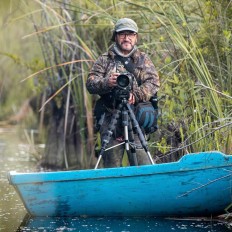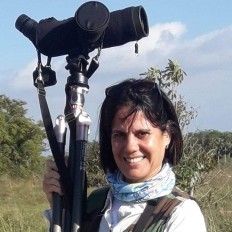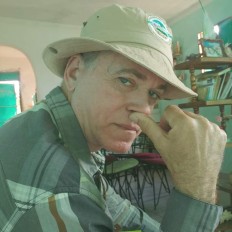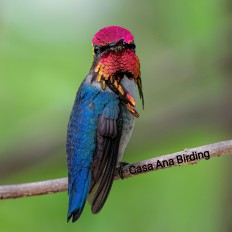Top species
- Blue-headed Quail-Dove (Starnoenas cyanocephala)
- Gray-fronted Quail-Dove (Geotrygon caniceps)
- Cuban Nightjar (Antrostomus cubanensis)
- Bee Hummingbird (Mellisuga helenae)
- Gundlach's Hawk (Accipiter gundlachi)
- Cuban Black Hawk (Buteogallus gundlachii)
- Bare-legged Owl (Margarobyas lawrencii)
- Cuban Pygmy-Owl (Glaucidium siju)
- Cuban Trogon (Priotelus temnurus)
- Cuban Tody (Todus multicolor)
- Cuban Green Woodpecker (Xiphidiopicus percussus)
- Fernandina's Flicker (Colaptes fernandinae)
- Cuban Parakeet (Psittacara euops)
- Zapata Wren (Ferminia cerverai)
- Zapata Sparrow (Torreornis inexpectata)
- Yellow-headed Warbler (Teretistris fernandinae)
- Cuban Oriole (Icterus melanopsis)
- Red-shouldered Blackbird (Agelaius assimilis)
- Cuban Blackbird (Ptiloxena atroviolacea)
- Cuban Bullfinch (Melopyrrha nigra)
- Cuban Grassquit (Phonipara canora)
List up to ca. 25 species that:
• have a limited distribution range and/or are rare on a global level
• are most sought-after by birdwatchers at this site
• and are relatively easy to see at this site (year-round or seasonally)
| Blue-headed Quail-Dove (Starnoenas cyanocephala) | |
| Gray-fronted Quail-Dove (Geotrygon caniceps) | |
| Cuban Nightjar (Antrostomus cubanensis) | |
| Bee Hummingbird (Mellisuga helenae) | |
| Gundlach's Hawk (Accipiter gundlachi) | |
| Cuban Black Hawk (Buteogallus gundlachii) | |
| Bare-legged Owl (Margarobyas lawrencii) | |
| Cuban Pygmy-Owl (Glaucidium siju) | |
| Cuban Trogon (Priotelus temnurus) | |
| Cuban Tody (Todus multicolor) | |
| Cuban Green Woodpecker (Xiphidiopicus percussus) | |
| Fernandina's Flicker (Colaptes fernandinae) | |
| Cuban Parakeet (Psittacara euops) | |
| Zapata Wren (Ferminia cerverai) | |
| Zapata Sparrow (Torreornis inexpectata) | |
| Yellow-headed Warbler (Teretistris fernandinae) | |
| Cuban Oriole (Icterus melanopsis) | |
| Red-shouldered Blackbird (Agelaius assimilis) | |
| Cuban Blackbird (Ptiloxena atroviolacea) | |
| Cuban Bullfinch (Melopyrrha nigra) | |
| Cuban Grassquit (Phonipara canora) |
Yellow-headed Warbler (Teretistris fernandinae) was added by Ernesto Reyes Mouriño (2021-08-14 17:18:51)
Cuban Blackbird (Ptiloxena atroviolacea) was added by Ernesto Reyes Mouriño (2021-08-14 17:18:09)
Cuban Oriole (Icterus melanopsis) was added by Ernesto Reyes Mouriño (2021-08-14 17:17:29)
Cuban Bullfinch (Melopyrrha nigra) was added by Ernesto Reyes Mouriño (2021-08-14 17:17:05)
Cuban Grassquit (Phonipara canora) was added by Ernesto Reyes Mouriño (2021-08-14 17:16:42)
Cuban Parakeet (Psittacara euops) was added by Ernesto Reyes Mouriño (2021-08-14 17:16:16)
Cuban Green Woodpecker (Xiphidiopicus percussus) was added by Ernesto Reyes Mouriño (2021-08-14 17:15:55)
Cuban Nightjar (Antrostomus cubanensis) was added by Ernesto Reyes Mouriño (2021-08-14 17:05:39)
Cuban Trogon (Priotelus temnurus) was added by Ernesto Reyes Mouriño (2021-08-14 17:05:02)
Cuban Tody (Todus multicolor) was added by Ernesto Reyes Mouriño (2021-08-14 17:04:47)
Red-shouldered Blackbird (Agelaius assimilis) was added by Ernesto Reyes Mouriño (2021-08-14 17:04:26)
Fernandina's Flicker (Colaptes fernandinae) was added by Ernesto Reyes Mouriño (2021-08-14 17:03:28)
Gray-fronted Quail-Dove (Geotrygon caniceps) was added by Ernesto Reyes Mouriño (2021-08-14 17:03:12)
Blue-headed Quail-Dove (Starnoenas cyanocephala) was added by Ernesto Reyes Mouriño (2021-08-14 17:02:47)
Bare-legged Owl (Margarobyas lawrencii) was added by Ernesto Reyes Mouriño (2021-08-14 17:01:58)
Cuban Pygmy-Owl (Glaucidium siju) was added by Ernesto Reyes Mouriño (2021-08-14 17:00:57)
Cuban Black Hawk (Buteogallus gundlachii) was added by Ernesto Reyes Mouriño (2021-08-14 17:00:38)
Zapata Sparrow (Torreornis inexpectata) was added by Ernesto Reyes Mouriño (2021-08-14 17:00:15)
Zapata Wren (Ferminia cerverai) was added by Ernesto Reyes Mouriño (2021-08-14 16:59:59)
Gundlach's Hawk (Accipiter gundlachi) was added by Ernesto Reyes Mouriño (2021-08-14 16:59:04)
Bee Hummingbird (Mellisuga helenae) was added by Ernesto Reyes Mouriño (2021-08-14 16:57:34)






